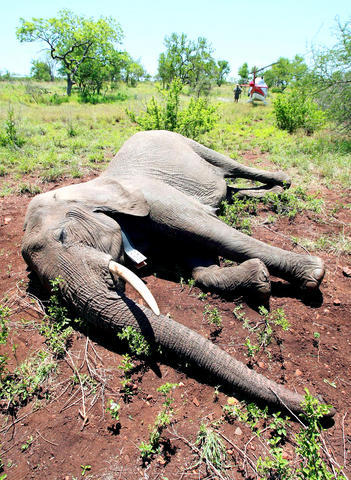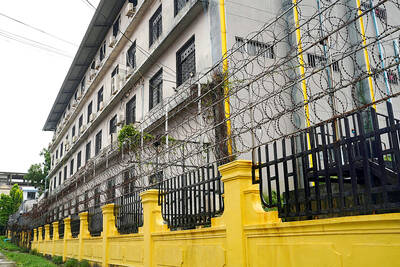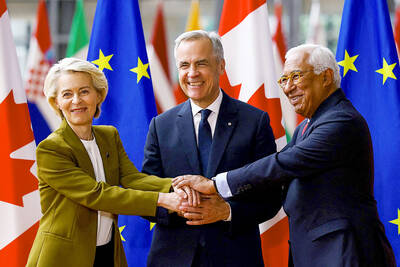South Africa will allow elephants to be killed in an attempt to control a burgeoning population, the government said, ending a 13-year ban and setting a trend that could embolden other southern African nations confronting the same dilemma.
As outraged animal rights activists threaten to promote tourist boycotts, South African Environment Minister Marthinus van Schalkwyk said on Monday the government had no choice but to reintroduce culling "as a last option and under very strict conditions."
There would be no "wholesale slaughter," he promised.

PHOTO: EPA
"Our simple reality is that elephant population density has risen so much in some southern African countries that there is concern about impacts on the landscape, the viability of other species and the livelihoods and safety of people living within elephant ranges," he said.
South Africa has been hugely successful in managing its elephant population, once on the verge of extinction in some areas. But it has become a victim of its own success and herds are growing at a rate of more than 5 percent a year and expected to double by 2020, threatening the delicate balance of nature.
There is no consensus on the continent on how to manage elephant populations. Southern African countries favor culling while East African nations such as Kenya are struggling to keep numbers up. Trade in ivory has been banned since 1989 to try to combat poaching despite appeals by South Africa to resume sales and invest the proceeds in its parks.
"We are the first country to come out and take this decision," van Schalkwyk said, adding that South Africa had consulted other countries in the region.
Monday's announcement follows months of heated debate, with some conservationists arguing that overall biodiversity should take priority and animal welfare groups outraged at the prospect of slaughter.
Van Schalkwyk said the debate was marked by "strong emotions."
The new regulations on managing elephants, effective May 1, say killing must be through "quick and humane methods," preferably by a single lethal shot to the brain by a skilled marksman from a helicopter.
The World Wildlife Fund (WWF) cautiously welcomed the government's move.
"They are doing the responsible thing," said Rob Little, acting chief executive of WWF South Africa. "It is the right choice to have culling as an option but with strong provisos."
However, Animal Rights Africa, which is threatening to promote tourist boycotts, said that killing elephants was "undeniably cruel and morally reprehensible."
Spokeswoman Michele Pickover said South Africa does not have too many elephants and that the decision by the government posed a threat to the elephant population in southern Africa.
She said: "South Africa has opened the door to en masse killing of elephants."
She argued that the decision was linked to its push to have the ban on ivory trade lifted. South Africa has huge stockpiles of ivory but if it succeeded in getting the ban lifted it would "have to keep looking for more ivory," Pickover said.
Bob Scholes, who headed the assessment report of elephant management, dismissed Pickover's claims as "irrelevant."
He said that elephants earned about 18.6 billion rand (US$2.42 billion) a year from tourists and only 1.14 billion rand in ivory, hunting and sales.
"Elephants are worth much more alive than dead," he said.

Drug lord Jose Adolfo Macias Villamar, alias “Fito,” was Ecuador’s most-wanted fugitive before his arrest on Wednesday, more than a year after he escaped prison from where he commanded the country’s leading criminal gang. The former taxi driver turned crime boss became the prime target of law enforcement early last year after escaping from a prison in the southwestern port of Guayaquil. Ecuadoran President Daniel Noboa’s government released “wanted” posters with images of his face and offered US$1 million for information leading to his capture. In a country plagued by crime, members of Fito’s gang, Los Choneros, have responded with violence, using car

CYBERCRIME, TRAFFICKING: A ‘pattern of state failures’ allowed the billion-dollar industry to flourish, including failures to investigate human rights abuses, it said Human rights group Amnesty International yesterday accused Cambodia’s government of “deliberately ignoring” abuses by cybercrime gangs that have trafficked people from across the world, including children, into slavery at brutal scam compounds. The London-based group said in a report that it had identified 53 scam centers and dozens more suspected sites across the country, including in the Southeast Asian nation’s capital, Phnom Penh. The prison-like compounds were ringed by high fences with razor wire, guarded by armed men and staffed by trafficking victims forced to defraud people across the globe, with those inside subjected to punishments including shocks from electric batons, confinement

Canada and the EU on Monday signed a defense and security pact as the transatlantic partners seek to better confront Russia, with worries over Washington’s reliability under US President Donald Trump. The deal was announced after a summit in Brussels between Canadian Prime Minister Mark Carney and European Commission President Ursula von der Leyen and European Council President Antonio Costa. “While NATO remains the cornerstone of our collective defense, this partnership will allow us to strengthen our preparedness ... to invest more and to invest smarter,” Costa told a news conference. “It opens new opportunities for companies on both sides of the

The team behind the long-awaited Vera Rubin Observatory in Chile yesterday published their first images, revealing breathtaking views of star-forming regions as well as distant galaxies. More than two decades in the making, the giant US-funded telescope sits perched at the summit of Cerro Pachon in central Chile, where dark skies and dry air provide ideal conditions for observing the cosmos. One of the debut images is a composite of 678 exposures taken over just seven hours, capturing the Trifid Nebula and the Lagoon Nebula — both several thousand light-years from Earth — glowing in vivid pinks against orange-red backdrops. The new image